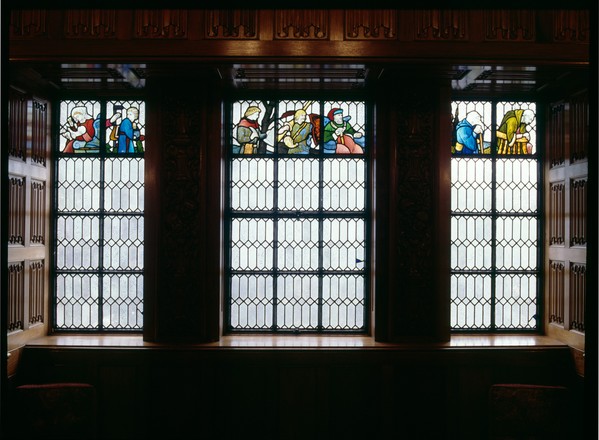Seven Ages of Man stained-glass windows
1942
This sequence of seven stained-glass windows depicts the stages of life so eloquently expressed in Shakespeare’s play As You Like It (Act II, Scene VII):
At first the infant,
Mewling and puking in the nurse's arms.
Then, the whining schoolboy with his satchel
And shining morning face, creeping like snail
Unwillingly to school.
And then the lover,
Sighing like furnace, with a woeful ballad
Made to his mistress' eyebrow.
Then a soldier,
Full of strange oaths, and bearded like the pard,
And then the justice
In fair round belly, with good capon lin'd,
The sixth age shifts
Into the lean and slipper'd pantaloon,
With spectacles on nose, and pouch on side,
Last scene of all,
That ends this strange eventful history,
Is second childishness and mere oblivion,
Sans teeth, sans eyes, sans taste, sans everything.
As we love it
One of Shakespeare’s most popular plays, As You Like It is a play written in the pastoral style, a literary tradition which has its roots in ancient Greece. Typically, a pastoral story involves an exile or escape from urban or court life, with characters who flee to the refuge of the countryside, often in disguise so they can talk with country folk about various aspects of life, from the merits and restrictions of court versus country living to nature, society, justice, culture and art. As You Like It develops many of the traditional features and concerns of the pastoral genre, examining the cruelties and corruption of court life, the pleasures and pains of being human, and the conventions of romantic love.
Don’t lose the plot
For its 2012 production of As You Like It, Sydney’s Belvoir Theatre described the play as:
The Forest of Arden: Orlando loves Rosalind. Rosalind is disguised as a boy called Ganymede. Phebe loves Ganymede. Silvius loves Phebe. Rosalind loves Orlando back. Oliver is hunting Orlando. Celia loves Oliver. Celia is disguised as Aliena. The Duke is hunting Celia. The other Duke is hunting deer. Jaques loves the deer. Touchstone is freaked out by Jaques. Audrey loves Touchstone. Touchstone loves words … It turns out to be quite a hard play to describe. In the end there’s a wedding and they all go home.
Taught by a master
Arthur Benfield learnt the art of designing and making stained glass from the Polish-born master John Radecki, who was the first Australian-trained stained-glass artist. After migrating to Australia with his family in the early 1880s, Radecki was taken on by the Sydney-based stained-glass manufacturer Ashwin & Falconer in 1885, and following Frederick Ashwin's death in 1909, became its chief designer. Radecki is responsible for many extraordinary windows around Sydney. His work is represented in the Library, including the Caxton window in the Mitchell Reading Room.
Arthur Benfield designed, drew and painted the images for the Shakespeare room as well as the Chaucer windows in the Mitchell Reading room. His work can also be found in many Sydney churches.



 Back to list
Back to list